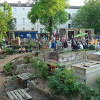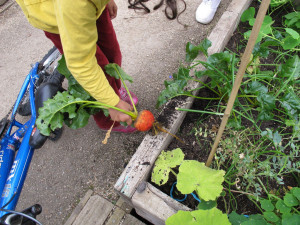‘Cabbages always follow the Peas’
Formed in 2011 the G3 Grower community is in their fourth season of planting. There were, however, two years of planning before the group gained access to the site. Previously the site was a derelict space used as a dumping ground and walled on four sides by tenements. Before that it was a motor garage. Due to previous uses, the land – because it contained pollutants – was unsuitable for growing, resulting in the G3 garden being a raised bed and pot plot. There are five raised beds with one used for herbs. The other four work on a planting rotation system growing a variety of produce – spinach, chard, Kale, Broccoli, potato, spring onion, beetroot, garlic, turnip, leaks, beans, Jerusalem Artichokes, raspberries, and of course “cabbages [that] always follow the peas”. Very much a nugget of vernacular knowledge this pea and cabbage system was explained thus: “don’t ask me the science stuff; cabbages just grow best after peas” (Volunteer). I was told “the science stuff” at a later date by the same volunteer: “The roots of peas and other legumes fix nitrogen in the soil as they grow. This benefits the cabbages and other brassicas planted on this site the following year”.
As well as the raised beds the group has six fruit trees and three large pots growing fauna planted specifically to attract and sustain bees. Other notable artefacts on site are four composters: two homemade using pallets, chicken wire and bits of carpet and two readymade plastic compost bins. Interestingly, the volunteers felt that the homemade composters were more effective, mainly because of easy access to the detritus, which allows for intermittent mixing, which distributes heat more evenly through the mix, which reduces the time of the transformation process. The garden has a poly tunnel, a tool shed and a homemade greenhouse. The wall panels of the latter were made in collaboration with children from a local nursery school. The greenhouse has a wooden structure, Perspex roof and walls made from columns of stacked two litre plastic bottles generously collected by the nursery school pupils. Visually this structure reminds me of some form of art instillation and to my eye looks impressive. Practically, it doesn’t fulfil its purpose as well as the group initially hoped. There is room for improvement however and the group are considering various options. There is no water access on site. The garden relies on collected rainwater that runs from gutters along the roofs of the shed and greenhouse into collection points. As backup the garden has three large water containers, topped up when necessary by the local fire brigade.
The garden site was set up in 2011 by Annexe Communities, a health and welfare charity based in Partick, using a grant they had obtained from the Climate Challenge Fund. The garden was officially transferred to G3 Growers the following year. Since then the group have received grants from Glasgow City Council Area Partnership (Anderston and City) for the purchase of gardening equipment and from CSV Action (Community Service Volunteers) for the bee pots and for rock dust to improve the soil. In addition to these funding sources, the 42 members are asked to make an annual voluntary contribution (suggestion £5), if they can afford to do so, to cover the on-going cost of seed and potting compost.
The group is a Non-Profit Community Group with constitution and committee with monthly meetings including an AGM. This constitutional form and attendant documents drawn up by the committee, (Child Policy, Inclusion Policy and Grievance Policy) was a requirement of the landowners and the council before the group could gain access to the land and apply for grants. The landowners are Glasgow West Housing Association (GWHA). The lease is a 15-year free term. One of the volunteers, a member of the committee, commented that both officials from GWHA and the City Council have been helpful throughout gardens evolution.
During my time at the garden I helped out de-stoning one of the raised-beds: this time of year, just before seeding, is taken up by a lot of de-stoning. This involved a small tool named a cultivator and a bucket (although other volunteers had a garden sieve that was more effective at keeping soil in the bed) and light labour. The volunteers conversed on all manner of subjects while working. Of particular note to our research, one conversation revolved around the opening of a new Tesco extra on Great Western Road on a once derelict site. The volunteers bemoaned the “invasion” of supermarkets into urban space. One volunteer, who has two children, felt that the supermarkets were making the city less safe for children. She explained that the opening of another Tesco extra on Argyle Street near her home had been followed by the closure of a few local small businesses. The small business owners, although not living in the immediate area, were, to her mind, members of the community. Her family and her neighbours knew these people on first name terms and, like other members of the community, the small business people looked out for the community’s children. She felt more at ease with her children out playing when she knew the guys from the local shop were going about their business. Tesco, she said, was too impersonal.
While de-stoning and chatting away with volunteers a group of medical students from the University of Glasgow arrived in the garden accompanied by a local GP. The local GP invited the students to the garden. The visit was part of a public health module offered by the university undergraduate medical degree program. The G.P believes that the garden is beneficial to the health and well-being of members of the community.
Another conversation of similar interest to our research centred upon what was perceived by three volunteers as a lack of exchange between the city’s community gardens. Two volunteers felt that it would be useful, in terms of sharing knowledge, to hear more regularly from other gardens. One volunteer felt that there was potential for gardens to share excess produce. It should be noted that another volunteer told me the G3 was set up to give local people the space to grow vegetables for their own use and was not large enough to provide excess produce.
Lack of visibility has been an issue for this group of growers who, while having adequate numbers of volunteers for their garden, would like to see other small communities around the G3 area take on similar garden back court projects. Since my visit there has been some progress on visibility. At the group’s request, Glasgow C.C. have obligingly put up pedestrian street signs on the corner of Kent Road and Argyle Street and also in Brechin Street directing people to ‘Community Garden’.
By Johnnie Crossan

